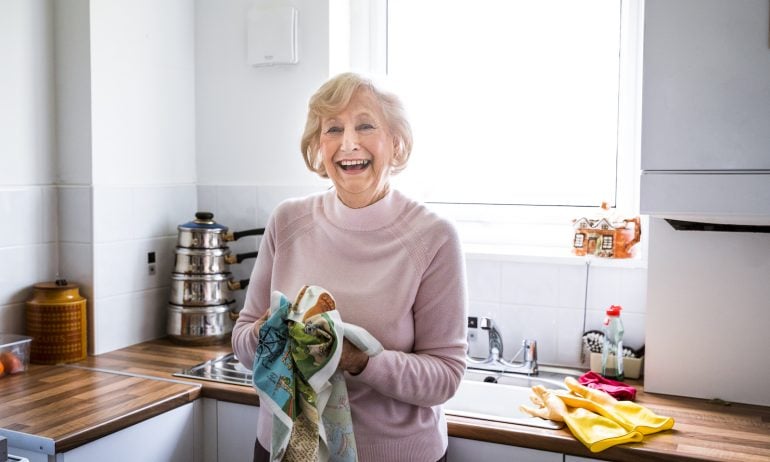Keeping ‘Solo Agers’ Happier and Safer
Millions of people are growing old without children they can rely on for help. Here are 3 ways they can prepare.

Many, or all, of the products featured on this page are from our advertising partners who compensate us when you take certain actions on our website or click to take an action on their website. However, this does not influence our evaluations. Our opinions are our own. Here is a list of our partners and here's how we make money.
Retirement coach Sara Zeff Geber visited several Northern California assisted living facilities to interview “solo agers” — people, either single or coupled, who don’t have children to help them as they grow older.
At many facilities, she couldn’t find any. That puzzled her until she realized that adult children are often the ones pushing the move into long-term care facilities.
“Who is it that gets mom or dad to move out of the two-story, single-family home?” says Geber, founder of LifeEncore coaching service in Santa Rosa, California. “The kids badger and cajole.”
Many people won’t have children to look after them as they age, either because they didn’t have kids or the ones they have aren’t available or reliable. Without that help, they face greater risks of isolation, financial exploitation, malnutrition and other ills, says Geber, author of “Essential Retirement Planning for Solo Agers.”
Who will let them know when it’s time to stop driving? Who will notice signs of physical or cognitive decline and find appropriate help? Who will pay their bills, vet their financial advisors and monitor their bank accounts? Who will hire and supervise caretakers or research nursing facilities when they can no longer care for themselves?
Thinking about these realities is hard but necessary, especially for the baby boomers in or approaching retirement, Geber says. The rate of childlessness doubled with the boomers, with 20% of women ages 40 to 44 being childless in 2005 compared to about 12% in 1986, when the first boomers hit their 40s, according to Pew Research Center. (The childless rate had declined to 15% by 2014.)
“[Solo agers] need to be thinking about how to stay safe and happy and satisfied with their life and connected throughout their life,” she says.
Step 1: Build a community
People who don’t expand their social networks can find themselves isolated and lonely as friends die or move closer to their grandkids. Strengthening ties with relatives and making new friends, particularly younger ones, can counteract that trend. So can cultivating relationships with neighbors, coffee shop buddies and other acquaintances. A 2014 study found people with more of these “weak tie” relationships reported being happier.
Step 2: Choose your home carefully
Your current home may not be the ideal place to grow older, especially if you won’t have many opportunities to socialize after you stop driving. But not everyone wants or can afford 55-plus developments, assisted living or continuing care retirement communities, which require residents to be healthy when they move in but then offer skilled nursing or long-term care to those who need it.
Some communities have organized “villages,” which are nonprofit associations typically created and staffed by residents of a neighborhood to provide services such as transportation and access to vetted service providers. “Co-housing,” where people build clusters of homes around shared spaces that encourage interaction, is another model available in some cities.
Or you could look for “naturally occurring retirement communities” where residents socialize and informally look out for each other. These communities can crop up in a variety of locations, including apartment houses, condos, mobile home parks and even tightknit neighborhoods of single-family homes. Other possibilities include sharing a place with other solo agers — “Golden Girls” style — or renting a room to a younger person.
Step 3: Enlist or hire your future guardians
Estate planning attorneys recommend all adults have documents in place that allow someone else to make decisions should they become incapacitated. These documents include powers of attorney for finances and for health care. (The medical power of attorney may also be called an advanced health care directive). Without this paperwork, solo agers could become wards of the court with strangers making decisions for them, Geber says.
Finding someone trustworthy to take over can be a challenge. A responsible younger friend or relative may be one option. In California and Arizona, people can hire licensed fiduciaries for this role, Geber says. Other states don’t have licensing for fiduciaries, she says, but people may be able to contract with professional guardians. An estate planning attorney or financial planner may be able to put you in touch with the appropriate professional.
Geber urges solo agers to take care of these tasks without delay. A health crisis or other disaster could upend their lives and they won’t have an adult child to help sort things out.
“The biggest problem I see for solo agers and all baby boomers is the denial” of what aging can bring, Geber says. “Open your eyes, do some planning.”
This article was written by NerdWallet and was originally published by The Associated Press.

